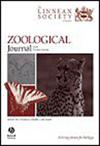Taxonomy and phylogeny of two planktonic hypotrichs, with establishment of a new family Pelagotrichidiidae (Protista: Ciliophora: Hypotrichia)
IF 2.8
2区 生物学
Q1 ZOOLOGY
引用次数: 0
Abstract
Hypotrich ciliates are a highly diverse, predominantly benthic group, with a few planktonic representatives identified. This study examines two planktonic hypotrich species from China: Pelagotrichidium faurei (Tuffrau, 1972) Jankowski, 1978, and Psilotrichides hawaiiensis Heber et al., 2018, using live observation, protargol impregnation, and SSU ribosomal DNA sequencing. The Chinese population of Ps. hawaiiensis closely resembles previous reports but has more ventral cirri. This is the first detailed account of the morphology, ontogenesis, and SSU ribosomal DNA sequence of Pe. faurei. Key ontogenetic features of Pe. faurei include: (i) the proter retains the parental adoral zone, while the opisthe develops a new oral primordium; (ii) five frontoventral anlagen form five cirral rows per daughter cell; (iii) marginal cirral rows and dorsal kineties develop intrakinetally, while dorsomarginal kineties develop de novo; and (iv) macronuclear nodules fuse into a single mass before division. Morphological, ontogenetic, and phylogenetic differences distinguish Pe. faurei from the spirofilid type genus Hypotrichidium Ilowaisky, 1921. Phylogenetic analyses place Pe. faurei within the strongylidiid clade, separate from the spirofilids. Based on these findings, we propose a new family, Pelagotrichidiidae fam. nov., to accommodate the genus Pelagotrichidium Jankowski, 1978.两种浮游下毛虫的分类和系统发育,并建立了一新科(原生目:纤毛虫目:下毛虫目)
亚营养纤毛虫是一个高度多样化的,主要是底栖动物群,有一些浮游生物的代表。本研究采用活体观察、原targol浸渍和SSU核糖体DNA测序等方法,对中国两种浮游低营养物种Pelagotrichidium faurei (Tuffrau, 1972) Jankowski(1978)和Psilotrichides hawaiiensis Heber等(2018)进行了研究。夏威夷斑蝶的中国种群与以前的报道非常相似,但有更多的腹侧cirri。这是Pe的形态、个体发生和SSU核糖体DNA序列的第一个详细描述。faurei。Pe的主要个体发生特征。原因包括:(1)亲本口区保留,而雌鸟发育新的口原基;(ii)每个子细胞有五个前腹角原形成五行环状;(iii)边缘行和背侧运动是相互作用发展的,而背侧边缘运动是从头发展的;(4)大核结节在分裂前融合成单个肿块。形态、个体发生和系统发生的差异区分了Pe。产自螺旋体型属Hypotrichidium Ilowaisky, 1921。系统发育分析表明Pe。刚体分支内的刚体分支,与螺体分离。基于这些发现,我们提出了一个新的科,Pelagotrichidiidae fam。11月,以容纳Pelagotrichidium Jankowski属,1978。
本文章由计算机程序翻译,如有差异,请以英文原文为准。
求助全文
约1分钟内获得全文
求助全文
来源期刊
CiteScore
6.50
自引率
10.70%
发文量
116
审稿时长
6-12 weeks
期刊介绍:
The Zoological Journal of the Linnean Society publishes papers on systematic and evolutionary zoology and comparative, functional and other studies where relevant to these areas. Studies of extinct as well as living animals are included. Reviews are also published; these may be invited by the Editorial Board, but uninvited reviews may also be considered. The Zoological Journal also has a wide circulation amongst zoologists and although narrowly specialized papers are not excluded, potential authors should bear that readership in mind.

 求助内容:
求助内容: 应助结果提醒方式:
应助结果提醒方式:


